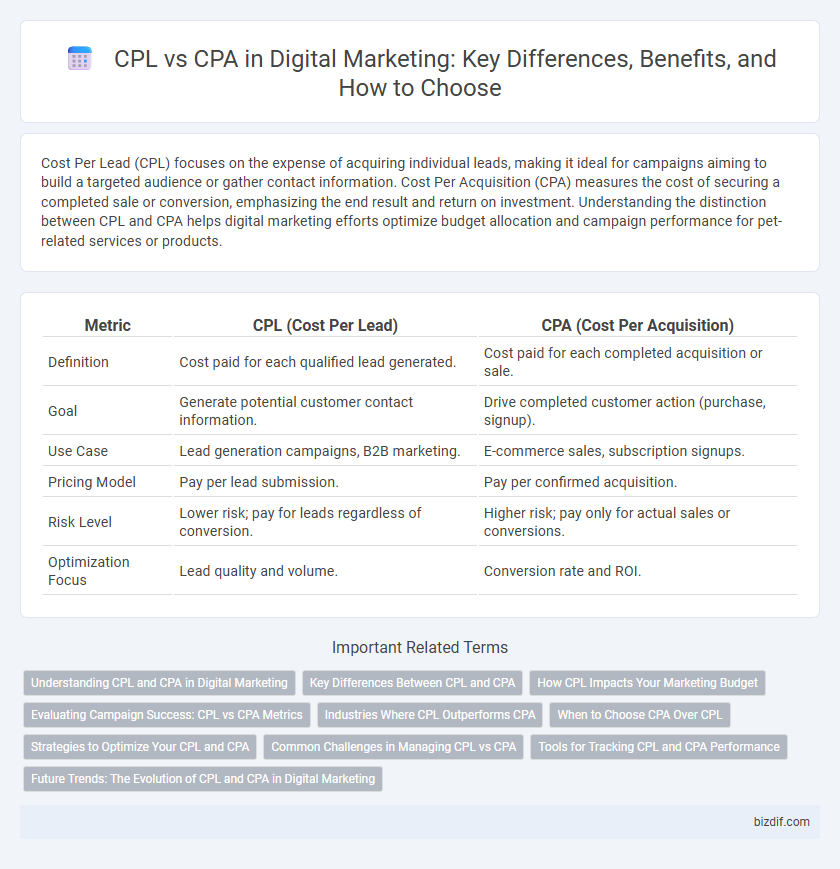Cost Per Lead (CPL) focuses on the expense of acquiring individual leads, making it ideal for campaigns aiming to build a targeted audience or gather contact information. Cost Per Acquisition (CPA) measures the cost of securing a completed sale or conversion, emphasizing the end result and return on investment. Understanding the distinction between CPL and CPA helps digital marketing efforts optimize budget allocation and campaign performance for pet-related services or products.
Table of Comparison
| Metric | CPL (Cost Per Lead) | CPA (Cost Per Acquisition) |
|---|---|---|
| Definition | Cost paid for each qualified lead generated. | Cost paid for each completed acquisition or sale. |
| Goal | Generate potential customer contact information. | Drive completed customer action (purchase, signup). |
| Use Case | Lead generation campaigns, B2B marketing. | E-commerce sales, subscription signups. |
| Pricing Model | Pay per lead submission. | Pay per confirmed acquisition. |
| Risk Level | Lower risk; pay for leads regardless of conversion. | Higher risk; pay only for actual sales or conversions. |
| Optimization Focus | Lead quality and volume. | Conversion rate and ROI. |
Understanding CPL and CPA in Digital Marketing
Cost Per Lead (CPL) measures the expense incurred to acquire a potential customer's contact information, making it essential for campaigns focused on lead generation. Cost Per Acquisition (CPA) tracks the total cost to secure a completed action, such as a sale or subscription, providing a clearer picture of campaign profitability. Understanding CPL and CPA metrics enables marketers to optimize budget allocation, improve conversion strategies, and enhance overall return on investment in digital marketing campaigns.
Key Differences Between CPL and CPA
Cost Per Lead (CPL) measures the expense incurred for acquiring a potential customer's contact information, prioritizing lead generation and audience engagement. Cost Per Acquisition (CPA) focuses on the actual cost of securing a sale or conversion, emphasizing finalized transactions and revenue generation. CPL campaigns typically optimize for volume and quality of leads, while CPA campaigns prioritize measurable sales outcomes and return on investment.
How CPL Impacts Your Marketing Budget
Cost Per Lead (CPL) directly influences your marketing budget by determining the expense necessary to acquire a potential customer's contact information. Lower CPL rates enable marketers to generate more leads within a fixed budget, enhancing lead volume and nurturing opportunities. Monitoring CPL against conversion rates ensures efficient allocation of funds toward campaigns that yield the highest return on investment.
Evaluating Campaign Success: CPL vs CPA Metrics
Evaluating campaign success requires analyzing CPL (Cost Per Lead) and CPA (Cost Per Acquisition) metrics to determine cost-efficiency and conversion effectiveness in digital marketing. CPL measures the expense to generate a lead, highlighting lead quality and volume, while CPA assesses the cost to secure a completed sale or desired action, reflecting direct ROI. Prioritizing CPA over CPL is crucial for campaigns focused on revenue, whereas CPL provides valuable insights for lead generation and nurturing strategies.
Industries Where CPL Outperforms CPA
CPL (Cost Per Lead) outperforms CPA (Cost Per Acquisition) in industries like real estate, education, and B2B services where generating qualified leads is more critical than immediate sales. These sectors benefit from CPL campaigns because leads allow for nurturing and longer sales cycles, making lead quality a priority over direct conversions. Tracking CPL provides marketers better control over lead volume and cost-efficiency in lead-driven markets compared to CPA's focus on final purchases.
When to Choose CPA Over CPL
Choose CPA (Cost Per Acquisition) over CPL (Cost Per Lead) when the primary goal is to drive actual sales or conversions rather than merely generating leads, ensuring marketing budget directly correlates with revenue outcomes. CPA is ideal for e-commerce stores, subscription services, or any business model where a completed purchase or sign-up is the key performance indicator. This approach minimizes financial risk by paying only for verified acquisitions, optimizing return on investment in performance marketing campaigns.
Strategies to Optimize Your CPL and CPA
Optimizing Cost Per Lead (CPL) and Cost Per Acquisition (CPA) requires targeted audience segmentation and precise ad placement to enhance conversion rates while minimizing expenses. Leveraging data analytics tools like Google Analytics and Facebook Pixel enables marketers to identify high-performing channels and adjust bids accordingly for better ROI. Implementing A/B testing on creatives and landing pages further refines strategy by revealing which elements decrease CPL and CPA for sustained campaign efficiency.
Common Challenges in Managing CPL vs CPA
Managing CPL (Cost Per Lead) and CPA (Cost Per Acquisition) campaigns presents unique challenges, including accurately attributing lead quality and conversion rates. CPL campaigns often struggle with lead validation and nurturing, while CPA campaigns require precise tracking of final sales or actions to ensure ROI. Balancing budget allocation and optimizing for both metrics simultaneously demands advanced analytics and continuous campaign adjustments to avoid overspending on low-quality leads or unconverted actions.
Tools for Tracking CPL and CPA Performance
Effective tracking tools for CPL (Cost Per Lead) and CPA (Cost Per Acquisition) performance include Google Analytics, HubSpot, and Facebook Ads Manager, which provide detailed insights into lead generation and conversion metrics. These platforms enable marketers to attribute spend accurately, optimize campaigns based on real-time data, and measure ROI across multiple channels. Advanced tracking integrations with CRM systems further enhance data accuracy and campaign effectiveness by linking leads and acquisitions to specific marketing activities.
Future Trends: The Evolution of CPL and CPA in Digital Marketing
Emerging trends in digital marketing reveal an increased integration of AI and machine learning to optimize Cost Per Lead (CPL) and Cost Per Acquisition (CPA) models, resulting in more precise targeting and budget allocation. Predictive analytics enhance the effectiveness of CPL by identifying high-quality leads earlier, while CPA benefits from real-time data to improve conversion tracking and ROI measurement. As privacy regulations evolve, marketers are adopting first-party data strategies and advanced attribution models to sustain the efficacy of CPL and CPA campaigns.
CPL vs CPA Infographic

 bizdif.com
bizdif.com